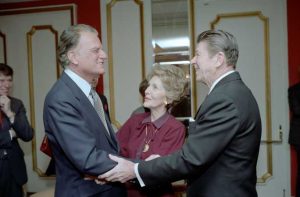Four sweeping “megatrends” are shaping the direction of planned gift philanthropy, and a nonprofit’s ability to adjust could determine success — or failure — in fundraising in the years ahead.
Those trends include: self-directed consumers, bypassing charitable planners at nonprofits, geopolitics, and the concentration of wealth. Those were the conclusions drawn from an extensive survey of the non- and for-profit sectors conducted by Cynthia W. Krause, principal of Wilson & Krause of Dallas, and Jeffrey W. Comfort, senior director of gift planning and principal gifts at Georgetown University in Washington, D.C. They presented the results of their study at the National Conference on Planned Giving, held recently in Nashville.
“As gift planners, our work is being shaped by the confluences of existing and emerging megatrends which are dramatically affecting the way we work, our alliances, and the donors, prospects and charities we serve,” they wrote in a paper accompanying their presentation. “Our ability to understand these trends and adjust our thinking and acting will spell the difference between success and failure in the future.”
The first megatrend they identified was the concept of the “self-directed consumer” brought about by the Internet, “which has produced as massive a change in our society as the printing press produced in the 1400s because it has spawned the democratization of information on every topic imaginable,” they wrote.
For the fundraiser, this means that information on gift planning is everywhere on the Internet, enabling prospects to educate themselves about giving techniques before even contacting a charity. This has led to declining response rates to traditional marketing techniques, such as newsletters, direct mail and seminars, they said. Increased competition among charities is also a factor in this trend.
“One of the primary and most frequently raised concerns of PG (planned giving) programs is the increasing failure of traditional marketing to produce results,” they wrote. The presenters recommended that charities focus their marketing approach on the charity’s mission “to capture prospects’ interests and direct their interests toward self-actualized philanthropy.”
While acknowledging there is “no clear panacea” to the marketing dilemma, they noted that the “most productive activities” include electronic marketing, enhanced segmentation and customization of personalized, targeted, enhanced focus on mission and “e-blasts.”
The second megatrend is that donors are bypassing charitable planners at nonprofits and going directly to “financial services people and/or their advisors to ask them for help with gifts.” While more discussions are taking place about charitable gifts between advisors and their clients, the charities are often not at the table with them.
To counter this, they wrote, charities should be educating prospects on why the organizations need to be involved in the gift planning process. One reason, they suggested, was to explain how their gifts will be used by the charity.
The third megatrend revolves around geopolitics and what they termed America’s new vulnerabilities. “There’s a level of uncertainty in the world … that has not been paralleled since the Great Depression and World War II,” Comfort said. “Nothing puts major gifts on hold like uncertainty.” Americans are much more cautious about their finances since Sept. 11, 2001. “The impact of this reality on gift planning has been profound.”
For example, charities have not only closed fewer charitable remainder trusts in recent years, they’ve found less interest in them as a planning concept because individuals would rather hold onto their assets than tie them up irrevocably, they wrote.
Comfort and Krause proposed that gift planners be flexible and “help donors handle uncertainty through revocable, even contingent gift commitments. For this and other development reasons, revocable gift recognition may be increasingly important.”
The final megatrend is the continuing, if not accelerating, concentration of wealth in the United States which leaves the wealthiest 1 percent of Americans controlling more than the bottom 90 percent. Smaller numbers of donors account for even larger shares of dollars raised, they said.
Charities need to focus on who the prospects are at the high levels and who also believe in the charity’s mission, they said. “If this is the Golden Age of Philanthropy…it’s going to be coming from very large estates” and perhaps we’re actually seeing the dawn of “megagifts,” Comfort said, adding that charities should be thinking about how to dedicate their resources to larger gifts.—NPT











